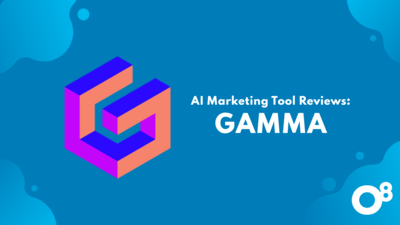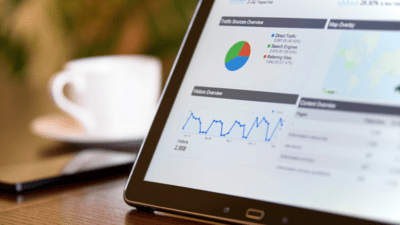How To Build a B2B Go-to-Market Strategy, According to Expert Practitioners

- Summary
- 1. Personas: Build your ideal customer profiles
- 2. Create a messaging document
- 3. Map your customer’s journey
- 4. Optimize your user’s experience (UX)
- 5. Define your marketing channels
- 6. Make ROI projections to get stakeholder buy-in
- 7. Set the key performance metrics (KPIs) and targets that define success
- 8. Come up with an ROI-tracking system
- Have O8 Build Your Go-to-Market Strategy
There is one language that every stakeholder speaks—numbers. Almost no one will reject a project, product, or partnership that clearly projects a profitable ROI. Wouldn't you increase your investment if you believed you could turn every dollar into ten?
Most businesses would. To earn more, they push their in-house marketing team to do more: podcasts, websites, emails, videos, and blog posts. This act-fast approach can be effective. Especially in a high-stakes situation where a project's results could mean the difference between a company hiring or laying off its employees, we understand sometimes it is better to be done than to be perfect.
However, most companies with product-market fit are rarely in a situation where a single marketing campaign will determine the company's fate. Instead, hesitancy from stakeholders' often comes from (1) wanting to see numbers first and (2) needing more trust in an ability to achieve them. This hesitancy often results in projects with unclear goals, roles, and expectations that bring confusion rather than business results.
A go-to-market (GTM) strategy gives stakeholders confidence that target initiatives will be profitable, with clear alignment on goals, work, and jobs to be done. It defines what you sell with details on who, where, how, and why decisions are being made.
O8's marketing industry veterans have encountered many clients who have unlocked new avenues for faster, higher growth after investing in a GTM strategy. Below are our eight experience-backed actionable steps to build yours and avoid becoming the exception.
Note: If you'd like O8 to build a go-to-market strategy that helps you accomplish your business goals faster, book a strategy call so we can assess your potential for growth at no cost.
1. Personas: Build your ideal customer profiles
An ideal customer profile describes the characteristics of a prospect or customer who would benefit most from your product or service. It serves as a single source of truth, delineating traits, preferences, and needs. It also informs essential elements in your business model like pricing strategy, sales strategy, target marketing, etc.
Marketing without clearly understanding who you aim to attract is like shooting in the dark. You might hit a few metric improvements that still fall short of your business goals.
If it hasn't clicked for you yet, our interactions with clients tell us this "drill" example can provide some clarity. Imagine you sell drills. Most potential customers don't want to hear about its speed, colors, or handle material. They don't want a drill at all. Instead, they care about making a hole, putting a screw in, and hanging their family photo. Hanging a family photo is their actual desire. Here, it's clear that the most effective marketing strategies focus on what your ideal customer profile truly wants to accomplish rather than what you are trying to sell.
In theory, you could remember to reference your target audience's needs, traits, and preferences without a document. But, looking back into your marketing campaigns, are they all aligned to a unified goal, offering what your customers need? Likely not, and that's fine; it's only human to let details sometimes fall through the cracks. To this end, the goal of a living persona document is to minimize and eliminate the chances you forget about what drives your customers and prospects, so every campaign has the foundation to be profitable.
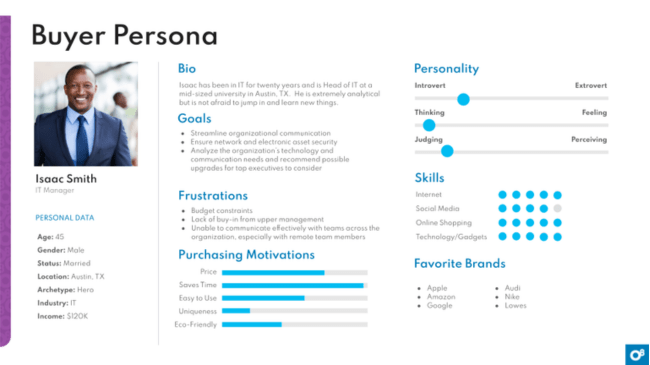
Sample O8 Buyer Persona
Include quantitative and qualitative data into your personas to make them comprehensive:
- Quantitative data tells you the "what" and gives you a broad market overview.
- Qualitative data reveals the "why" behind your customers' actions and helps you understand their motivations and needs.
Both types of data give you a complete understanding of your target customers, which is why we gathered them for a medical SaaS client.
One of the activities we did on the qualitative front was to talk to the sales team, those interacting with customers and prospects daily. These interviews clarified marketing messages that persuaded prospects to book a demo, the consequences to their personal lives that they’d face if they didn’t solve their problem, and competitors’ solutions that they are also considering.
We then looked at external data that backed or refuted our findings:
- The U.S. Census Bureau is where we gathered that most of our client’s customers were middle-class health professionals who identified as female.
- SparkToro, a consumer analytics tool, then validated our assumptions around our core demographic information, media consumption, and interests.
- LinkedIn, where we searched for real-life examples of healthcare professionals who fit the profile to see how they talk, who they engage with, and the types of publications they read.
Based on these insights, we crafted an ICP for our client. We can’t share it for privacy reasons, but it detailed the story of a healthcare professional in their mid-30s to late 50s who owns or operates a small clinic or private practice in urban or suburban areas. With this knowledge, we went on to produce marketing messages that truly persuaded new customers to buy, exactly as you would.
2. Create a messaging document
A messaging document encapsulates phrases, unique value propositions, and stories that help you have a customer-first mindset regarding writing and content development.
This means putting yourself in the shoes of your ICP and assessing what messages or content they need to hear at each phase of their journey to progress forward. Having a well-defined messaging document also helps maintain consistency in what you say, how you say it, and why you say it.
Scattered or misaligned messages can confuse customers looking to buy your product or service, as they need clarity, not conflicting information about your business.
You can use a message house as your guiding single source of truth for your team to align. It's the framework we use at O8 because it's simple to explain, understand, and brief, helping both sales and marketing departments stay on the same page.
A message house typically has three or more parts and can be expanded upon if needed. As the foundation, it should have the following components:
- The WHY - The roof holds the main message that all your communications should align with. This is often your company's most compelling value proposition, mission, or purpose. Use the following structure as guidance: "We exist to [make something better/solve a common problem/overcome obstacles]."
- The HOW and WHAT - Three or more columns with messages that support your main message. These messages should highlight how you do what you do differently and better than everyone else.
- The WHO - A foundation of data that supports other social proof, statistics, examples, and testimonials. People should read this data and know why your product or service is an excellent choice for them.
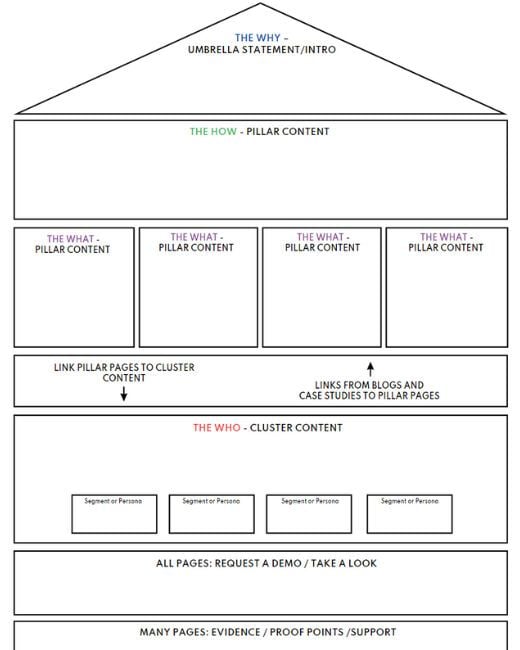
Example of a comprehensive O8 message house
Our message houses include more detail than the message house's creator intended. We like to dig deeper, specifying messages that resonate with subsets of our audience to address more niche service offerings.
You don't need this level of detail to benefit from a message house. Let's take the example of a message house that Mark Fest, the creator of the message house, presented in his free e-book.
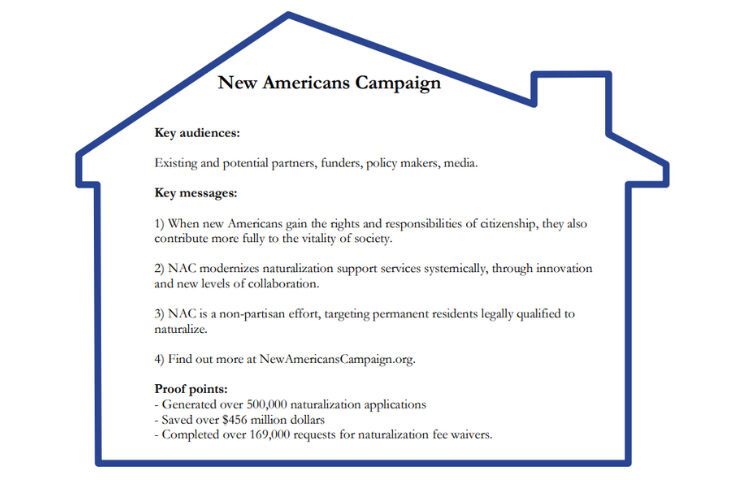
It’s for the New Americans Campaign, “a coalition of service providers aiming to modernize and streamline the delivery of naturalization assistance to legal permanent residents in the United States.”
You can easily create a Message House using the free Message House Toolkit's templates.
3. Map your customer’s journey
A "Customer journey" depicts the touchpoints and steps an average prospect encounters on the road to becoming customers, fans, and brand advocates—like a roadmap. Prospects who fall under the same ideal customer profile have different pain points depending on their stage in the journey. Jumping straight into marketing execution without a journey map can leave gaps where customers might fall out of their path to conversion. You also increase the risk of overinvesting in a message or effort that doesn't fit their stage or level of awareness.
Here's a case in point: GenoPalate, a direct-to-consumer brand, approached O8 because it routinely achieved high website traffic but low conversion rates. While mapping their customer journey, we discovered that prospects learning about GenoPalate through its website were upper-middle-class women looking to lose ten pounds. They needed straightforward, actionable guidance, not overly complicated, and deeply clinical scientific information.
We created distinct landing pages for their different customer profiles. Some of these pages were aimed at website visitors who didn't know about GenoPalate at all, while others targeted people with at least some familiarity with their brand.
The customer journey was designed to begin from the homepage. Visitors were immediately asked to choose their primary interests (such as weight loss, improved fitness, disease management, etc.) from a drop-down menu prominently displayed in the homepage feature area. Once visitors arrived at the resulting landing page, they could download distinct e-books that enrolled them into unique email sequences.
Here's a look at our concept prior to design and development:
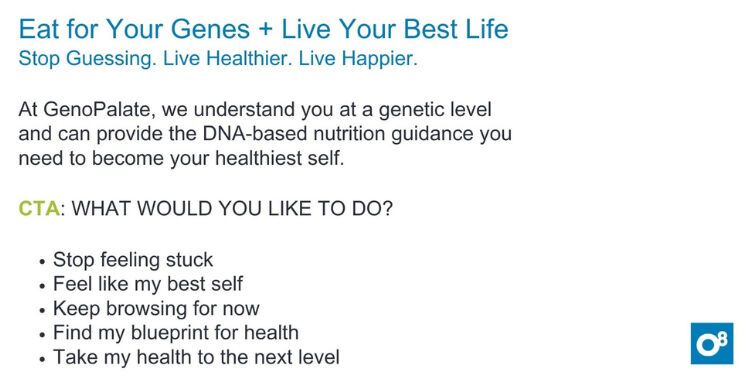
By mapping the customer journey and implementing personalized UX and messaging strategies, GenoPalate saw a significant lift in their conversion rates. Here, the implementation of personalized landing pages was the most meaningful next step toward relevancy for their distinct customer segments.
To map your customer journey, ask yourself questions like:
- What channels or sources did they use to discover us?
- Were there any specific incentives or factors that tipped the scale?
- What ultimately led the customer to choose our product or service?
- How did the customer first become aware of our existing products or services?
- What specific information did the customer look for during their research?
- Did they encounter any difficulties or obstacles during the purchasing process?
As with customer profiles, conversations with those client-facing roles directly interacting with customers will help you map your buyer’s journey. For more data-backed insights, you can also lean on tools indicating how users interact with your current marketing channels.
For example, Hotjar is a widget you can install on your website that records privacy-protected use recordings. You can witness how people scroll, click, and navigate your site’s pages. Hotjar also generates heat maps on demand. You can see how far visitors scroll down a page, what sections or elements they click on, and what they ignore.
Hotjar in use
These direct visuals and context clues complement data from Google Analytics and Google Search Console. As you acquire a more complete picture of the customer journey through your website, this information is what aids business decision-makers in making real strategic decisions rather than acting on assumptions.
4. Optimize your user’s experience (UX)
You often have as little as 50 milliseconds to make an impression on your ideal customers. Making your website experience as easy and hassle-free as possible is crucial.
Your challenge is that 96% of unhappy customers don’t voice complaints. Given how these people at least have a relationship with you, we believe the number of unhappy prospects that remain silent is just as high or worse.
These realities leave you with two challenges.
First, optimizing your user experience (UX) is critical to close sales. By ensuring a seamless and enjoyable process for your potential customers, you can significantly increase your chances of converting them into paying customers. Optimizing your customer experience involves making every touch point as intuitive, engaging, and rewarding as possible:
- Information architecture: Create clear navigation menus, intuitive categorization, and effective search functionalities so users can easily find the information they need and accomplish their tasks efficiently. A well-structured website architecture also helps search engines easily find and index information on your site, resulting in improved search rankings.
- Visual design: Pay attention to typography, colors, spacing, and imagery to create a cohesive and aesthetically pleasing experience. Align the visual design with your brand identity to reinforce brand recognition and evoke positive emotions.
- Optimize website performance: Users expect fast load times and seamless interactions. Perform rigorous testing to identify and fix any performance issues hindering the user experience.
Second, prospects and customers won’t always tell you what they like or don’t like. It’s up to you to create hypotheses around what could be going wrong, gather data to test the hypotheses and correct the course. For example, we like to use Hotjar to playback the exact page sessions from our website. We aim to check if the website structure we designed is as simple to navigate as we expected.
To get started, identify the critical components that will make a significant difference. This could include key user flows, core functionalities, or high-traffic areas of the website. By concentrating your efforts on these areas, you can optimize the most important aspects of the user experience. Address these pressing challenges before moving on to lower-priority improvements.
5. Define your marketing channels
Different channels can attract different audiences and subsets of people at different times for diverse reasons. For example, TikTok is often more attractive and engaging for teenagers than for senior adults. So what if you need a platform to sell fitness apps to upper-middle-class women between 29 and 38 looking to lose ten pounds? The more precise you focus the lens, the more complex the targeting can become.
Your gut feeling can take you to a certain point of confidence, especially if you’ve built it from successful marketing campaigns. However, it can also blind you to other avenues or channels where your ICPs spend time and energy.
For example, Emerson, our client, needed help finding workers for their factory. They considered using LinkedIn Ads, as they had experience with the platform. Our analysis revealed that the target individuals spent considerably more time on Meta not LinkedIn. We also learned that there was urgency attached to the project, meaning that long-term activities such as in-depth content development weren’t an option. The proposition, calls to action, and implementation had to be clear and concise.
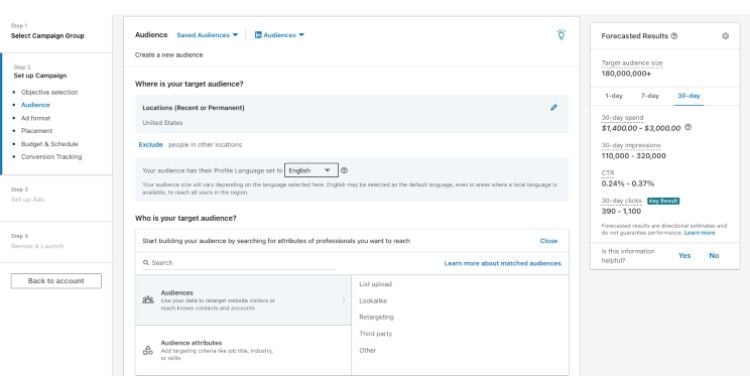
While we could have found some of the workers on LinkedIn’s Ad platform, they frequented Meta more, making Facebook a more effective channel
We referenced the demographic information provided by our client to construct audiences in Meta ads for the type of applicants they needed. Creative assets were reviewed with productive discussions, which led to the correct details and CTAs. We were confident that the ad impressions would persuade ICPs to apply, including our client’s competitive pay, signing bonus, and flexible working hours. We launched Meta Ads (Facebook and Instagram) in various formats to entice people to consider our client for employment.
Multiple hiring campaigns spanning multiple weeks (and sometimes months) were placed through Meta. Through these campaigns and other tactics deployed by the client (particularly billboards), suitable candidates began applying for the positions. Importantly, the multiple campaigns (some using video, others using static imagery) helped us and our client learn what worked best for this type of recruitment.
Subsequent campaign review discussions with experts at Meta validated our methods and gave us additional thoughts for future campaigns. We, of course, were delighted that our clients reported favorably about the inflow of candidates to hire.
While the problem may not be hiring competent talent, the approach remains the same. You need to find a customer base that fits a specific description and resonates with certain messages. If you’ve followed our tips so far, you should have this information in a customer profile and messaging document.
If you don’t know where your customers are, or there’s a disconnect between where your customers said they spend their time and where they do, fear not! You can start multiple low-scale campaigns, gather data, and double down on the most profitable platforms.
6. Make ROI projections to get stakeholder buy-in
At O8, we always keep this phrase from strategy advisor Chris Brogan in mind during every client engagement: "My favorite metric is the one with a dollar sign in front of it." While your CMO might enjoy the nuances of your go-to-market plan, most executives will half-listen until you provide an ROI (Return on Investment) number.
Projected ROI helps leaders compare their investment options and feel more confident about putting resources into their new product or service. It also signals you're serious about delivering real, measurable results.
Calculating ROI can be tricky because you need to consider all the costs and outcomes involved. For example, you spend $20,000 on ads to make $100,000. It looks like you made five times what you spent. But it's much less after including other costs, such as the marketing team who ran the ads and the sales teams who spoke with prospects.
To get a more accurate ROI, look at all the contributing factors like ad spend, customer acquisition costs, other expenses like employee salaries, and the total revenue generated. Altogether, this gives you a more accurate understanding of whether your marketing investment was profitable.
All our strategic projects include an ROI projection stage. We follow certain principles to make this information actionable and digestible:
- Keep it simple: Use clear and easy-to-understand language. Make sure the information flows logically and isn't overwhelming.
- Use visuals: Include charts, graphs, or pictures to help stakeholders visualize the projections and make the information more immediately understandable.
- Show the benefits: Highlight the positive outcomes the project will deliver. Use numbers to demonstrate how it will increase revenue, save costs, or improve customer satisfaction.
- Address risks: Talk about potential challenges or risks that could affect the projections. Explain your plans to overcome them and assure stakeholders that you've considered these factors.
- Align with their goals: Connect the projections to the stakeholders' priorities and interests. Show how the project supports their strategic objectives or solves their problems.
These projections convey a compelling case for the project's potential returns and align stakeholders' expectations with the anticipated outcomes. If you can effectively communicate the projected ROI, you'll increase the likelihood of gaining stakeholder buy-in and support for your initiatives.
7. Set the key performance metrics (KPIs) and targets that define success
Before diving into this topic, let’s explain the difference between “targets” and KPIs.” Targets are the specific goals you want to reach: the outcome you expect to achieve due to your efforts. KPIs (Key Performance Indicators) are the specific measurements used to assess the performance of business activities (such as a digital display ad campaign, for example). In other words, KPIs inform you of whether you’re likely to achieve your targets (or not).
For example, let's say you've set a target of increasing website traffic by 20% in the next quarter. The KPIs associated with this target could be metrics like website visits, unique visitors, or page views.
KPIs align team members on what the finish line looks like. Your marketing efforts avoid becoming fragmented and disjointed because your team has a shared understanding of business priorities and whether or not achieving the associated targets is on track.
Think of it this way: KPIs in service of your targets help avoid duplicate work, conflicting strategies, and wasted resources. Instead of acting like a group of people rowing a boat in different directions and going in circles, you're all rowing in the same direction with a common destination in mind.
Tracking KPIs helps not only your immediate team. You can provide senior executives with incremental snapshots and forecasts. You can have fact-formed discussions among your team and with leaders about actions to be taken if the successful achievement of a target is at risk.
Sometimes, targets might even be reset due to what the data tells you. This is a game changer for marketers and executives. KPIs are based on what's really happening. Without this information, vanity metrics like blog post output can take away your attention from your initial goal, such as generating inbound leads.
How do you start with KPIs?
Begin developing a KPI document by analyzing the results of past successful marketing campaigns. Here’s an example of a template:
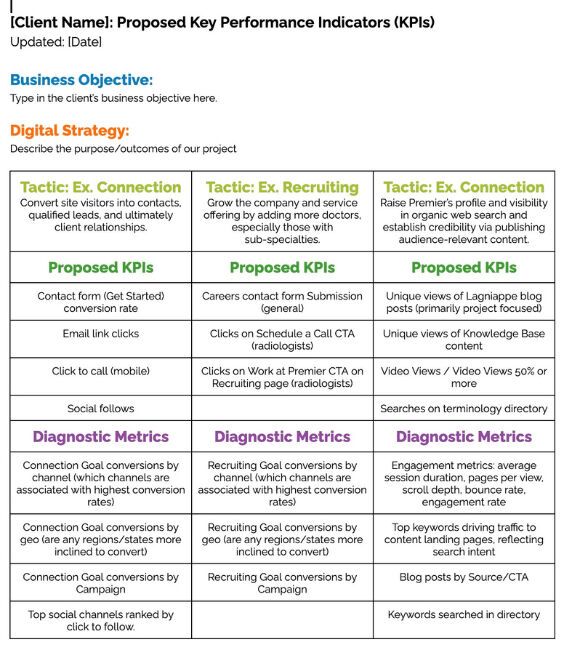
Use the data you already have to understand what's realistically achievable. If you don't have existing data, look for industry benchmarks or review other internal data that might give you clues, such as checking your project management tool to verify how long it takes to write a blog article or publish a new landing page.
Look for trends, patterns, and benchmarks to set your targets. For example, suppose you're focusing on increasing organic website traffic through SEO efforts. In that case, you might target a 10% or 20% quarter-over-quarter growth in site traffic based on industry standards or previous performance. This percent increase is your KPI for web traffic.
Where can you find data to set targets and KPIs?
If you’ve never set targets or are new to tracking data, an easy way to start is by looking at website data coming from Google Analytics, Google Search Console, and your content management system (CMS). Chances are you can access at least one of these tools to find data such as web form submission counts, retention rates, demo requests, or e-books downloaded.
Our encouragement to you is simple: You have to start somewhere, and you’ll improve your ability to set targets and KPIs over time. Resetting targets and KPIs as your new analysis habits take hold is common.
Finally, an important caveat: Remember that other business realities can affect your ability to achieve the projected results. Factors like adverse weather, economic downturns, new competitive entries, and many others can influence business outcomes.
8. Come up with an ROI-tracking system
An ROI-tracking system is the last step toward proving the value of a go-to-market strategy and bringing peace of mind to stakeholders. The channels you chose in step six determine how you’ll report on your investment’s profit.
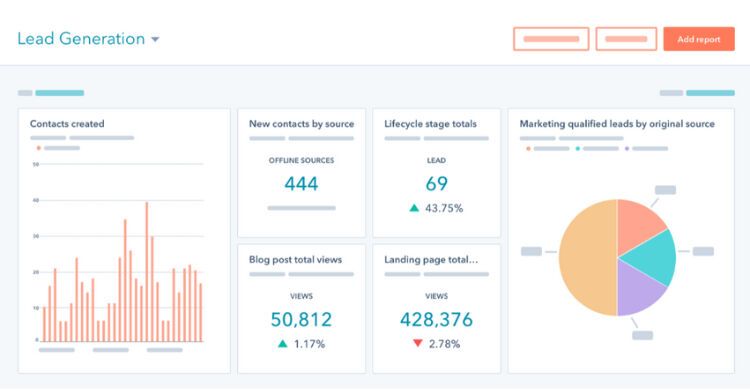
Sample Inbound Lead Generation Dashboard
Paid advertising platforms (such as Meta, Google, and LinkedIn) are incentivized to show detailed ROI reports because they need to demonstrate their worth to advertisers. If you can see and interpret the reporting, you can reliably share this information with stakeholders. It becomes easier to decide whether investing in specific initiatives and the associated channels is a good idea. That’s why these platforms make ROI information available.
Inbound campaigns are harder to measure. For example, there’s no straightforward method to track customers who saw a billboard of your brand seven months ago and bought a product today. You could ask them how they learned about you during their buying journey. Some companies don’t reliably do this because adding too many steps to the sales process can demotivate prospects from buying.
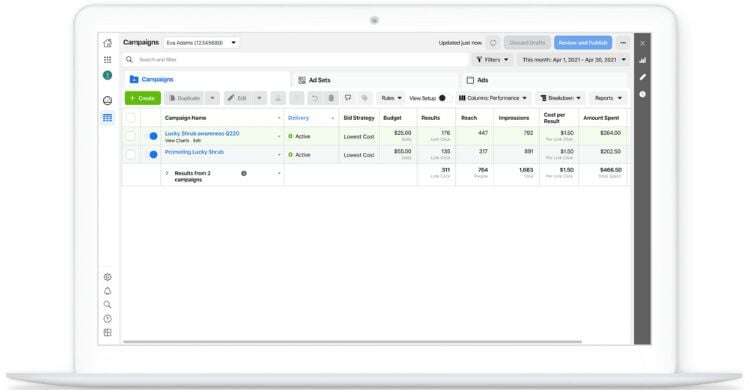
Meta’s Ad Manager
Still, we suggest regularly analyzing the data from your ROI-tracking system. Look for trends, patterns, and areas that need improvement. This information will guide you in refining your marketing approach, optimizing your campaigns, and making smart decisions based on data to achieve better results.
Have O8 Build Your Go-to-Market Strategy
O8’s team comprises marketing industry veterans with VP, directive, and other senior executive positions at B2B companies like yours. We’ve used go-to-market strategies to grow companies during budget cuts, layoffs, pressing needs, unclear priorities, and all the unideal situations you might be going through.
If you want to work with an agency that lives and breathes GTM, gives you the number to build a case for any project, and won’t tie you into inflexible contracts and bloated deliverables, book a free growth strategy call with us.



